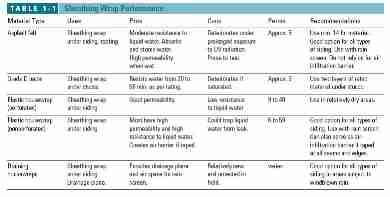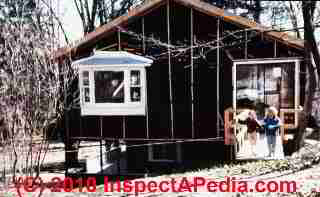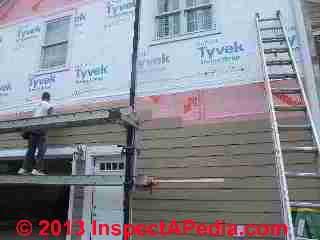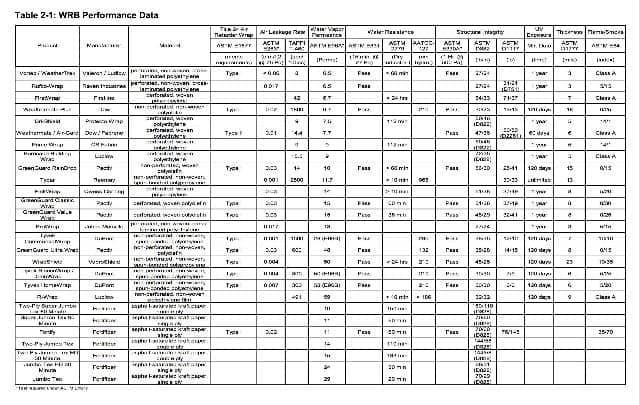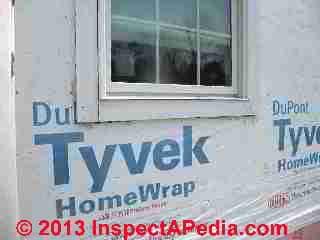 Guide to Housewrap Products & Choices
Guide to Housewrap Products & Choices
- POST a QUESTION or COMMENT about what housewrap or building wrap products are available & about the properties of different housewraps
Buyers's guide to housewraps & vapor or moisture or rain barrier products:
This article describes choices and properties of moisture barrier or housewrap products. Page top photo: DuPont Tyvek HomeWrap® house wrap is shown during the removal of a problematic fiber cement siding installation, courtesy Galow Homes.
Discussed here: . How different housewrap products satisfy the rain screen principle. Buyer's guide to sheathing wrap / house wrap on buildings. Where to buy flashing membranes & flashig tapes for use on buildings at housewrap joints & around windows, doors.
This article series discusses best practices construction details for building exteriors, including water and air barriers, building flashing products & installation, wood siding material choices & installation, vinyl siding, stucco exteriors, building trim, exterior caulks and sealants, exterior building adhesives, and choices and application of exterior finishes on buildings: paints, stains.
InspectAPedia tolerates no conflicts of interest. We have no relationship with advertisers, products, or services discussed at this website.
- Daniel Friedman, Publisher/Editor/Author - See WHO ARE WE?
Building Sheathing Wrap Materials & Choices
Article Contents
- HOUSEWRAP PRODUCT CHOICES
- HOUSEWRAP DATA TABLE - table of specifications, wind & water resistance, perm ratings for 27 housewrap products
This article series includes excerpts or adaptations from Best Practices Guide to Residential Construction (Steve Bliss, J Wiley & Sons) , by Steven Bliss, courtesy of Wiley & Sons.
Installed carefully, any of the sheathing wraps can perform well and keep water out of walls.
The three main choices are traditional asphalt felt, Grade D building paper, and the newer plastic housewraps. The optimal product will depend upon the siding choice, building details, and climate.
With any sheathing wrap material, however, the key to good performance is to carefully lap the material to shed water.
This job has been made easier by the introduction of a number of peel-and-stick membranes for use around windows, doors, and other trouble spots. General performance characteristics of sheathing wraps are summarized in Table 1-1 below.
Using Asphalt Felt as Building Wrap
Asphalt roofing felt, has a perm rating of around 5 and moderately good water resistance, making it suitable for use as a sheathing wrap. However, unlike plastic housewraps, asphalt felt will absorb water when wet.
Once wet, its permeability jumps from around 5 to as high as 60. In the event of water leaking into the wall, asphalt felt may help store some of the water, and its high permeability when wet will promote drying to the exterior. Housewrap, in contrast, tends to trap any liquid water that gets behind it.
Some contractors find felt easier to install and weave into flashings because of its rigidity and narrow roll width.
Felt, however, tends to get brittle and deteriorate under long-term exposure to UV radiation [not that there is much UV radiation exposure of felt when it is located underneath building siding-DF] and is more prone to tear during installation than plastic housewraps. For situations where prolonged exposure is expected, plastic housewraps are better suited. Otherwise, asphalt building felt remains a valid choice for modern homes.
Although traditional 15-pound rag felt weighed 15 pounds per 100 square feet, the material sold today as No. 15 felt is made of recycled cardboard and sawdust and actually weighs only 7 to 8 pounds per square. Most of the lightweight building paper sold has no ASTM rating.
ASTM-rated No. 15 felt is either a minimum of 7.6 pounds per square (ASTM D4689) or 11.5 pounds per square (ASTM D226). Similarly, the unrated variety of No. 30 felt typically weighs only 15 to 20 pounds per square versus 26 to 27 pounds for rated Type 2 felt (ASTM D226).
Using Grade D Building Paper for Building Wrap
Grade D building paper is an asphalt-impregnated kraft-type paper, similar to the backing on fiberglass insulation. Unlike asphalt felt, it is made from new wood pulp, rather than recycled material. Its most common use is under stucco in the western United States.
The vapor permeance of Grade D paper is similar to asphalt felt. Its liquid water resistance ratings range from 20 to 60 minutes, as measured by using the boat test (see Water Resistance
in "WATER RESISTIVE BARRIERS ON BUILDING EXTERIOR WALLS").
Because Grade D paper tends to deteriorate under prolonged wetting, the trend in three-coat stucco is to use two layers of 30-minute paper. Because the paper tends to wrinkle, the two layers tend to form a small air space, creating a rain-screen effect.
- Details about using roofing felt or 15 pound felt as a housewrap or vapor barrier are
at FELT 15# ROOFING, as HOUSEWRAP/VAPOR BARRIER
Guide to Buying & Using Plastic Housewrap on buildings
There are a wide range of plastic housewraps on the market. Most are nonwoven fabrics made from either polyethylene or polypropylene.
Some synethetic house wrap products have perforations to let water vapor pass through and the others are designed to let water vapor diffuse through the fabric itself.
Photo at left: two brands of housewrap (DuPont Tyvek HomeWrap® and Owens Corning PinkWrap®) are exposed during the removal of a failed fiber cement siding installation job. Photo provided courtesy of the repair contractor, Galow Homes[4].
Because there is no single testing standard for plastic housewrap performance, it is difficult to make apples-to-apples comparisons. However, published performance data and limited field studies suggest the following:
- Permeance to water vapor. The leading non perforated
products (Tyvek®, R-Wrap®, and Amowrap®) are significantly
more permeable to water vapor, ranging
from 48 to 59 perms, than nearly all the perforated
materials.
See PERM RATINGS of BUILDING MATERIALS for details . - Water resistance. All sheathing wraps adequately shed water on vertical surfaces. Pooled water, however, will leak through most perforated plastic housewraps over time, while the non perforated materials will contain liquid water indefinitely. No. 15 asphalt felt retains water moderately well, but it allows some penetration over time.
- Damage from extractives. Some researchers have noted that extractives leaching out of redwood and cedar siding can cause plastic housewrap to lose its water repellency and to deteriorate. Back-priming the wood siding or leaving an air space behind the siding will help prevent this. Stucco will also degrade plastic housewrap and is rarely installed over it.
- Recommendations. Given their high permeance ratings
and excellent resistance to liquid water, the non perforated
housewraps are a good choice for most building
applications. Traditional asphalt felt is also a good
option.
Many contractors find plastic sheathing wraps more convenient than asphalt felt in that they weigh only 1 to 2 pounds per square, and they are more flexible in the cold and more tear-resistant. Also they are available in 9- to 10-foot-wide rolls versus 3-foot rolls for asphalt felt.
Table of WRB Performance Data: Air & Water Leakage & Perm Ratings for 17 Housewrap Products
The table below, excerpted from Kaellner (2006) cited above and atReferences or Citations , lists 27 housewrap products, giving manufacturer, air retarder rating, air leakage rates, water vapor permeance or perm rating, structural integrity, UV exposure rating, thickness, and flame/smoke classification for these products (listed in order of lowest to highest Perm rating:
Vorted / Weather Trek, Rufco-wrap, FirstWrap, Weathermate Plus, Dri-Shield, Weathermate / Air-Gard, Prime Wrap, Barricade Building Wrap, GreenGuard RainDrop, Typar, PinkWrap, GreenGuard Classic Wrap, ProWrap, Tyvek ComemrcialWrap, GreenGuard Ultra Wrap, WrapShield,Tyvek StuccoWrap / DrainWrap, Tyvek HomeWrap, R-Wrap, Two-Ply Super Jumbo Tex 60 Minute, Super Jumbo 60 Minute, Fortify, Two-Ply Jumbo Tex, Two-Ply Jumbo Tex HD 30 Minute, Jumbo Tex HD 30 Minute, Jumbo Tex.
[Click to enlarge any table or image at InspectApedia.com]
Guide to Choosing & Installing Draining Housewraps
In the last few years, manufacturers have responded to the need for an air space and drainage plane with a variety of housewrap products that are either wrinkled or corrugated to provide an integrated air space.
These include products intended primarily for stucco, such as DuPont’s StuccoWrap®, and others developed for siding, such as Raindrop Housewrap, which is a plastic drainage mat from Pactiv, Inc. (see “Resources,” page 47).
The air space created by these products is minimal, ranging from 0.02 inch thick for StuccoWrap to 0.008 for RainDrop®. Although these materials may allow for some drainage, it is unlikely that they will provide any measurable airflow to promote drying.
A more promising approach is a 1/4-inch nylon matrix, called HomeSlicker®, which has vertical drainage channels and installs between the sheathing wrap and siding. The material is rigid and thick enough to resist compression by the siding but thin enough that windows, doors, and trim can be installed without furring.
- - Adapted with permission from Best Practices Guide to Residential Construction (Steve Bliss, J Wiley & Sons) .
Producers of Plastic or Other Housewrap Products
- Benjamin Obdyke www.benjaminobdyke.com Homeslicker drainage mat and Homeslicker Plus Typar
- DuPont www.construction.tyvek.com Tyvek, HomeWrap, and StuccoWrap
- FirstLine www.firstlinecorp.com FirstWrap
- Johns Manville www.jm.com ProWrap perforated housewrap
- Ludlow Coated Products www.ludlowpc.com Barricade housewrap, Weathertrek draining housewrap
- Owens Corning www.owenscorning.com PinkWrap and PinkWrap Plus Pactiv www.pactiv.com Classic wrap, Ultra wrap, and Raindrop Housewrap
- Reemay www.typarhousewrap.com Typar housewrap
Grade D Building Paper
- Fortifiber Co. www.fortifiber.com
- Hal Industries www.halind.com
...
Reader Comments, Questions & Answers About The Article Above
Below you will find questions and answers previously posted on this page at its page bottom reader comment box.
Reader Q&A - also see RECOMMENDED ARTICLES & FAQs
On 2021-01-25 - by (mod) -
Rich:
Housewrap is "non-directional" - either side can go out. You'll often see housewrap installed both ways on the same building: notice that in some areas the imprint is facing out and in other areas the installer stapled it up with the writing facing "in" - it makes no difference, it'll work properly in either direction.
But when installing housewrap do take care to lap it properly - bottom edges of an upper section being installed always lap OVER the upper edge of teh lower section already installed - etc. Else water will find its way behind the housewrap.
On 2021-01-24 by Rich
Are most house wraps none directional ( Tyvek is non directional) in other words no inside or outside as far as function is concerned ?
On 2020-08-25 by Steve
Is there a significant quality difference between Hydro Gap Synthetic House wrap and Henry Weathersmart House Wrap?
On 2019-05-23 - by (mod) -
Thank you for the interesting question, Kevin.
I agree that building along any sea coast or along the shores of lakes like Lake Superior expose homes to driven rain and high wind, making detailing of the building exterior really important during construction.
In my OPINION, once we've selected a drainable housewrap, the concern is not so much which housewrap product is selected but in exactly how it is installed, how we handle details around building openings like windows and doors, how the housewrap is secured to the building (staples?) ,
how it's overlapped, how much care is taken to be sure all overlaps are in the right direction, how the drainage plane beneath the siding is preserved, and even basic snafus like installing the housewrap with the wrong side "out" (the printed side goes out).
Some coastal builders install double-coverage housewrap on their homes, working up from the bottom, installing runs of housewrap that overlap enough that there are in effect two layers of material.
Typical specification from model building codes: All overlaps in a building wrap must overlap 6 inches where two pieces join vertically, and 2 inches at horizontal seams. The first course should begin around a corner a minimum 12 inches (or to the first stud) and overlap the sill plate 1 to 2 inches.
Housewraps marketed as specifically designed for the extra-demand of coastal building include
NapaWrap Coastal house wrap
HydroGap Drainable House wrap - Benjamin Obdyke
DELTA-VENT SA, which is a self-adhesive, water and air resistant barrier. DELTA-VENT SA has three layers.
Typar HouseWrap
All of these describe their products as specifically suited for coastal building.
Possibly Weathersmart is designed for that application too - you might want to contact Henry Co. directly. I read the company's product description and found myself quickly out of breath and, low on oxygen, confused.
Quoting: https://henry.com/residential-and-light-commercial/weather-resistive-air-barriers/weathersmart
WeatherSmart
WeatherSmart represents a new generation in housewrap technology, offering an intelligent housewrap solution one that delivers the ideal balance between water intrusion protection and moisture vapor breathability; so it can be used in any climate and behind most exterior claddings. The product is a polymeric weather-resistive barrier, utilizing a high-strength nonwoven substrate and a monolithic non-perforated coating of smart polymers. Its unique construction protects against the elements-while being extraordinarily durable and UV stable.
Part of the Fortifiber 1-2-3 moisture control system, WeatherSmart is designed to withstand the rigors of the jobsite and the elements, and is backed by an industry-leading 15-year warranty.
On 2019-05-21 by Kevin
What is better for Maine coastal climate typar or weathersmart esr-1027?
On 2018-02-12 - by (mod) -
John
Rex Wrap is a hybrid "woven plastic" rather than a synthetic fibre housewrap, described as follows by http://www.alphaprotech.com/product/176.aspx?catid=30
EX™ Wrap is a tear resistant woven and coated polypropylene weather resistant barrier that provides air and moisture protection.
It relies on perforations to permit moisture vapor breathing.
On 2018-02-09 by John
Is Rex Wrap (AlphaProTech) a comparable product to Tyvek?
I live in a coastal saltwater marsh area and very exposed to wind driven rain. I have Hardie siding on two levels and stucco on the lowest (garage level).
thank you,
john
On 2017-01-04 - by (mod) -
John,
Use a housewrap like Tyvek, Typar, etc. These are breathable membranes. They help keep driven rain and water out but will not trap moisture within the wall.
On the interior, if you gut walls to studs or are laminating drywall over old plaster and if there are no vapor barriers installed, you could install a poly vapor barrier on the warm side.
However since the 1980's we've known that the most important points of intrusion of indoor moisture into wall cavities is at penetrations: holes, gaps, leaks such as around wall receptacles, lights, or other openings. Pay attention first to those.
Finally, look at the areas of peeling on the exterior as indicators of where there are special leak problems: either exterior or interior leaks into the walls.
On 2017-01-04 by John
I am not in the building trades. Having read the article about moisture I would like your thoughts on best wrap material for my situation:
100 yrs old house, no wall insulation or vapor barrier, in Northern Pennsylvania
want to vinyl side but concerned about trapped moisture in wall cavity moving from inside to out
moisture diffusion has lifted paint off cedar shakes for the last 50+ years - heavy peeling
thanks, John
...
Continue reading at HOUSEWRAP at SILLS, SOLES, TOP PLATES or select a topic from the closely-related articles below, or see the complete ARTICLE INDEX.
Or see these
Recommended Articles
- BASEMENT CEILING VAPOR BARRIER
- CRAWL SPACE VAPOR BARRIER LOCATION
- FELT 15# ROOFING, as HOUSEWRAP/VAPOR BARRIER
- HOUSEWRAP AIR & VAPOR BARRIERS
- HOUSEWRAP INSTALLATION
- HOUSEWRAP INSTALLATION DETAILS
- HOUSEWRAP PRODUCT CHOICES
- HOUSEWRAP at SILLS, SOLES, TOP PLATES
- MOISTURE in BUILDING WALLS, EFFECTS
- MOISTURE CONTROL in BUILDINGS
- PERM RATINGS of BUILDING MATERIALS
- STUCCO WALL WEEP SCREED DRAINAGE
- VAPOR BARRIERS & AIR SEALING at BAND JOISTS
- VAPOR BARRIERS & CONDENSATION
- VAPOR BARRIERS & HOUSEWRAP
- VAPOR BARRIERS, VINYL SIDING
- VAPOR CONDENSATION & BUILDING SHEATHING
- WATER BARRIERS, EXTERIOR BUILDING
Suggested citation for this web page
HOUSEWRAP PRODUCT CHOICES at InspectApedia.com - online encyclopedia of building & environmental inspection, testing, diagnosis, repair, & problem prevention advice.
Or see this
INDEX to RELATED ARTICLES: ARTICLE INDEX to EXTERIORS of BUILDINGS
Or use the SEARCH BOX found below to Ask a Question or Search InspectApedia
Ask a Question or Search InspectApedia
Questions & answers or comments about what housewrap or building wrap products are available & about the properties of different housewraps.
Try the search box just below, or if you prefer, post a question or comment in the Comments box below and we will respond promptly.
Search the InspectApedia website
Note: appearance of your Comment below may be delayed: if your comment contains an image, photograph, web link, or text that looks to the software as if it might be a web link, your posting will appear after it has been approved by a moderator. Apologies for the delay.
Only one image can be added per comment but you can post as many comments, and therefore images, as you like.
You will not receive a notification when a response to your question has been posted.
Please bookmark this page to make it easy for you to check back for our response.
IF above you see "Comment Form is loading comments..." then COMMENT BOX - countable.ca / bawkbox.com IS NOT WORKING.
In any case you are welcome to send an email directly to us at InspectApedia.com at editor@inspectApedia.com
We'll reply to you directly. Please help us help you by noting, in your email, the URL of the InspectApedia page where you wanted to comment.
Citations & References
In addition to any citations in the article above, a full list is available on request.
- [1] Best Practices Guide to Residential Construction, by Steven Bliss. John Wiley & Sons, 2006. ISBN-10: 0471648361, ISBN-13: 978-0471648369, Hardcover: 320 pages, available from Amazon.com and also Wiley.com. See our book review of this publication.
- Steve Bliss's Building Advisor at buildingadvisor.com helps homeowners & contractors plan & complete successful building & remodeling projects: buying land, site work, building design, cost estimating, materials & components, & project management through complete construction. Email: info@buildingadvisor.com
Steven Bliss served as editorial director and co-publisher of The Journal of Light Construction for 16 years and previously as building technology editor for Progressive Builder and Solar Age magazines. He worked in the building trades as a carpenter and design/build contractor for more than ten years and holds a masters degree from the Harvard Graduate School of Education. Excerpts from his recent book, Best Practices Guide to Residential Construction, Wiley (November 18, 2005) ISBN-10: 0471648361, ISBN-13: 978-0471648369, appear throughout this website, with permission and courtesy of Wiley & Sons. Best Practices Guide is available from the publisher, J. Wiley & Sons, and also at Amazon.com - [2] a href="http://galowconsulting.com/">Paul Galow - technical consultant on networking, LAN design, applications support. Galow Consulting Services [Website galowconsulting.com ] , 914-204-1749, email: paulgalow@galowconsulting.com
- John Rudy, Advantage Home Inspections, Flemington N.J. 08822 home inspector, 908-806- 6364, Home, Radon & Termite Inspections, Central & Parts of North New Jersey, email: jonadvantage1@yahoo.com
- [3] "Leaky Housewraps", Paul Fisette, Building Materials and Wood Technology, web-search 4/17/2008 - 2010, original source: http://www.umass.edu/bmatwt/publications/articles/leaky_housewraps.html -
This page is maintained by the Building and Construction Technology program in the Department of Environmental Conservation, University of Massachusetts Amherst. David Damery, Program Director, Room 118, Holdsworth Natural Resources Center, University of Massachusetts, Amherst, MA 01003, Tel: +1 (413) 545-1770, email: ddamery@nrc.umass.edu - Butt, Thomas K., FAIA, “Water Resistance and Vapor Permeance of Weather Resistive Barriers,” Journal of ASTM International, November/December 2005, Vol. 2, No. 10,www.intres.com/about/pub/WeatherBarriers.pdf, November 2005.
- Ahuja, Deepak, B. Matthew Smith, and M. Arch. "Potential Pitfalls of a Green Building Material: A Case Study of Cellulose Insulation." In Forensic Engineering 2012@ sGateway to a Safer Tomorrow, pp. 239-249. ASCE, 2013.
- Gibson, Scott. "Air and Vapor Barriers." Fine Homebuilding 4, no. 94 (1994): 48-53.
- Hazleden, Donald G., and Paul I. Morris, Ph.D., “The Influence of Design on Drying of WoodFrame Walls Under Controlled Conditions,” in Proceedings: Performance of Exterior Envelopes of Whole Buildings VIII, Integration of Building Envelopes, Clearwater Beach, Florida, December 2-7, 2001.
- International Building Code (2006),
- "Leaky Housewraps", Paul Fisette, Building Materials and Wood Technology, web-search 4/17/2008 - 2010, original source: http://www.umass.edu/bmatwt/publications/articles/leaky_housewraps.html -
This page is maintained by the Building and Construction Technology program in the Department of Environmental Conservation, University of Massachusetts Amherst. David Damery, Program Director, Room 118, Holdsworth Natural Resources Center, University of Massachusetts, Amherst, MA 01003, Tel: +1 (413) 545-1770, email: ddamery@nrc.umass.edu - Kaellner, Bradford R., "Attachment# 14 Impact Of Title 24 Residential Leakage Reduction Credit On Water-resistive Barriers In California Homes", Architectural Energy Corporation, Boulder CO, USA, for California Energy Commission, Public Interest Energy Research Program, (2006).
- Listiburek, Joseph W., "Chubby CHecker and the "Fat Man" Do Permeance", ASHRAE Journal, June 2015 pp. 58-64
- “Weather-Resistive Barriers: How to select and install housewrap and other types of weatherresistive barriers,” U.S. Department of Energy, www.eere.energy.gov/buildings/info/documents/pdfs/28600.pdf, October 2000.
- Weston, Theresa A., Ph.D., and Xuaco Pascual, “The Function and Performance of WeatherResistive Barriers During Building Construction,” Performance of Exterior Envelope of Whole Buildings IX International Conference, December 5-10, 2004.
- Weston, Theresa A., Ph.D., Michel Stachnik, Ph.D., James Waggoner, “Development of a Textured Spun-Bonded Polyolefin Water Barrier for Stucco and EIFS,” ASHRAE Transactions 2001, V. 107, Pt. 1, 2001.
- Our recommended books about building & mechanical systems design, inspection, problem diagnosis, and repair, and about indoor environment and IAQ testing, diagnosis, and cleanup are at the InspectAPedia Bookstore. Also see our Book Reviews - InspectAPedia.
- Decks and Porches, the JLC Guide to, Best Practices for Outdoor Spaces, Steve Bliss (Editor), The Journal of Light Construction, Williston VT, 2010 ISBN 10: 1-928580-42-4, ISBN 13: 978-1-928580-42-3, available from Amazon.com
- In addition to citations & references found in this article, see the research citations given at the end of the related articles found at our suggested
CONTINUE READING or RECOMMENDED ARTICLES.
- Carson, Dunlop & Associates Ltd., 120 Carlton Street Suite 407, Toronto ON M5A 4K2. Tel: (416) 964-9415 1-800-268-7070 Email: info@carsondunlop.com. Alan Carson is a past president of ASHI, the American Society of Home Inspectors.
Thanks to Alan Carson and Bob Dunlop, for permission for InspectAPedia to use text excerpts from The HOME REFERENCE BOOK - the Encyclopedia of Homes and to use illustrations from The ILLUSTRATED HOME .
Carson Dunlop Associates provides extensive home inspection education and report writing material. In gratitude we provide links to tsome Carson Dunlop Associates products and services.


